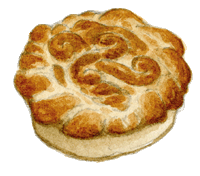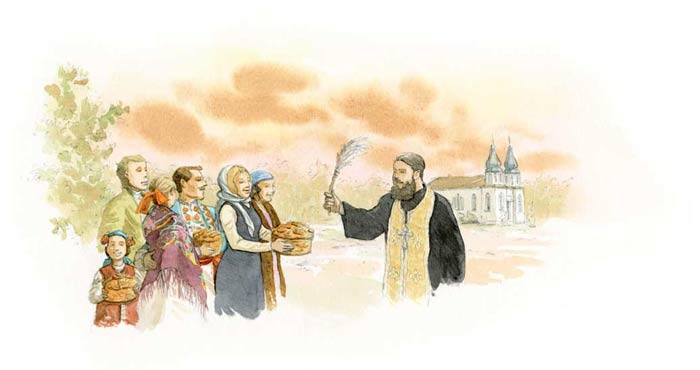Paska

Form: Fat round brioche, decorated
Country of origin: Ukraine
What distinguishes it from other methods of bread making: Dough similar to brioche
Category of bread: (10) Belongs to this category of breads for special days, for which much care is taken to enrich and embellish it for the special day, such as Irish barmbrack, or Afghan katlama
Particularity: It is cleverly decorated to commemorate both the resurrection of Christ and the arrival of spring
Ingredients: Wheat flour; baker’s yeast; warm water; eggs; butter; salt; sugar

Ukraine
The Christian Orthodox world celebrates Easter with much enthusiasm. In the Ukraine, each family makes its own paska with the utmost care. The woman on whom this task falls must adopt an irreproachable moral attitude, and the household must remain totally peaceful so as not to interfere with the whole process of making the bread. No neighbors or strangers must come into the house: they might cast an evil eye on the Easter bread. The idea of this is that the future of the community is directly subject to the “moral” quality of the paska. Easter bread must be “good”, both in spiritual and gastronomic terms.
The recipe for paska is passed down from one generation to another, and entails know-how and use of the same gestures that have been used since time immemorial. In this case, it is not so much an Easter bread as the act of making it to mend one’s ways, to transform oneself, as written in 1 Corinthians 5:6-8:
Your glorying is not good. Do you not know that a little leaven leavens the whole lump? 7 Therefore purge out the old leaven, that you may be a new lump, since you truly are unleavened. For indeed Christ, our Passover, was sacrificed for us.[a] 8 Therefore let us keep the feast, not with old leaven, nor with the leaven of malice and wickedness, but with the unleavened bread of sincerity and truth.
The word “leaven” is obviously used here in the metaphorical sense, since Ukrainian bread, unlike the Jewish Pessa’h bread, contains the addition of the principle of fermentation. What else does it contain? Wheat flour, warm water, eggs, butter, salt and sugar. The dough is left to rise to twice its volume, and then divided into three dough rolls. The first two are shaped in circles the diameter of a greased baking pan with high sides, and then one of them is place on top of the other in the pan. The last one is used to make strips that are braided, and then put on top of the paska, along with other decorative elements such as crosses, vegetable-base objects, etc. The top is slathered with egg yellows to help it turn golden brown, then baked in a moderate oven for 45 minutes. Paska is then taken to the church, where it is consecrated following the resurrection mass.

